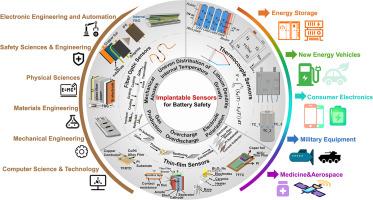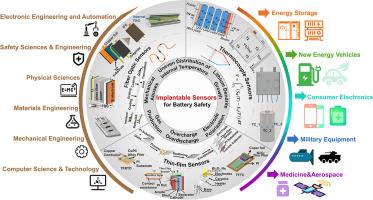嵌入式传感:电池安全监测中的神经前沿和预警革命
IF 20.2
1区 材料科学
Q1 CHEMISTRY, PHYSICAL
引用次数: 0
摘要
电池系统的迅速普及使得防止热失控成为一项至关重要的技术。基于原位传感器的监测框架能够实时跟踪内部参数,从而为热管理提供早期预警和干预措施。然而,传统的传感器受到其单维结构的限制,难以准确地捕捉热、机械和化学领域之间复杂的相互作用。在整个生命周期中,当预测多物理场条件下的电池退化时,这种限制会导致明显的盲点。因此,推进多参数传感技术和开发多维传感体系结构是实现电池全面安全监测的必要条件。从嵌入式传感的角度来看,本文系统地研究了与传感器集成过程中遇到的化学相容性、测量精度和多参数监测相关的关键挑战。它详细阐述了热电偶、光纤传感器和薄膜传感器在电池中的工作原理和实际应用。为了解决技术瓶颈,例如结构完整性风险、电解质诱发的性能下降以及单参数监测的局限性,我们提出了包括传感器小型化、化学坚固材料的选择、集成多维原位平台以及人工智能(AI)技术的结合等策略。这篇综述促进了对电池多维传感系统的全面理解,显著增强了主动安全工程和多物理场诊断框架。本文章由计算机程序翻译,如有差异,请以英文原文为准。


Embedded sensing: The neural frontier and early-warning revolution in battery safety monitoring
The rapid proliferation of battery systems has positioned thermal runaway prevention as a crucial technological imperative. In-situ sensor-based monitoring frameworks enable real-time tracking of internal parameters, thereby providing early warnings and interventions for thermal management. However, conventional sensors, limited by their unidimensional architectures, struggle to accurately capture the intricate interplay among thermal, mechanical, and chemical fields. This limitation results in significant blind spots when predicting battery degradation under multiphysics conditions over the entire lifecycle. Consequently, advancing multi-parameter sensing technologies and developing multidimensional sensing architectures become essential for achieving comprehensive battery safety monitoring. From an embedded sensing perspective, this review systematically examines critical challenges related to chemical compatibility, measurement accuracy, and multi-parameter monitoring encountered during sensor integration. It provides a detailed elaboration on the operating principles and practical applications of thermocouples, optical fiber sensors, and thin-film sensors in batteries. To address technological bottlenecks, such as risks to structural integrity, electrolyte-induced performance degradation, and limitations in single-parameter monitoring, we propose strategies that include sensor miniaturization, the selection of chemically robust materials, integrated multidimensional in-situ platforms, and the incorporation of artificial intelligence (AI) technologies. This review advances comprehensive understanding of battery multidimensional sensing systems, significantly enhancing active safety engineering and multiphysics diagnostic frameworks.
求助全文
通过发布文献求助,成功后即可免费获取论文全文。
去求助
来源期刊

Energy Storage Materials
Materials Science-General Materials Science
CiteScore
33.00
自引率
5.90%
发文量
652
审稿时长
27 days
期刊介绍:
Energy Storage Materials is a global interdisciplinary journal dedicated to sharing scientific and technological advancements in materials and devices for advanced energy storage and related energy conversion, such as in metal-O2 batteries. The journal features comprehensive research articles, including full papers and short communications, as well as authoritative feature articles and reviews by leading experts in the field.
Energy Storage Materials covers a wide range of topics, including the synthesis, fabrication, structure, properties, performance, and technological applications of energy storage materials. Additionally, the journal explores strategies, policies, and developments in the field of energy storage materials and devices for sustainable energy.
Published papers are selected based on their scientific and technological significance, their ability to provide valuable new knowledge, and their relevance to the international research community.
 求助内容:
求助内容: 应助结果提醒方式:
应助结果提醒方式:


